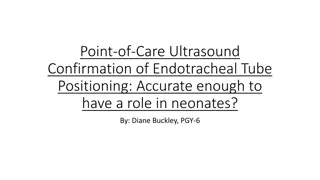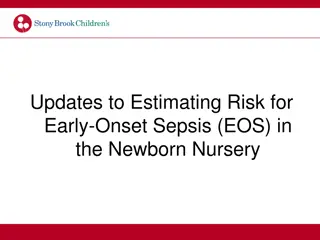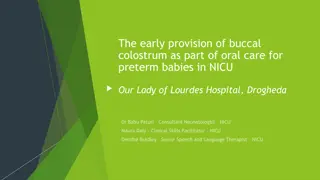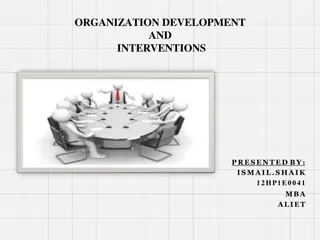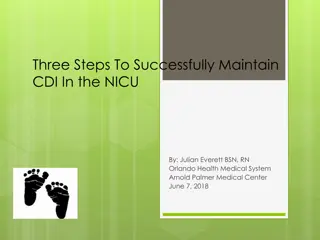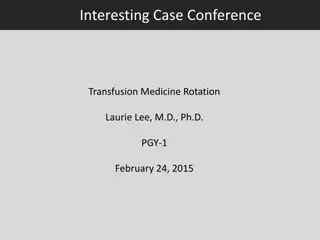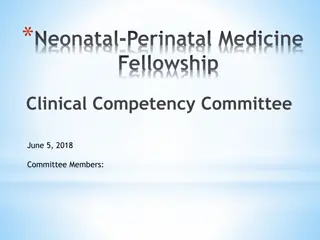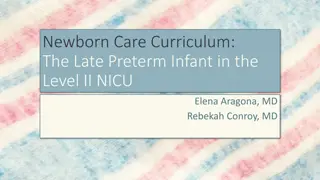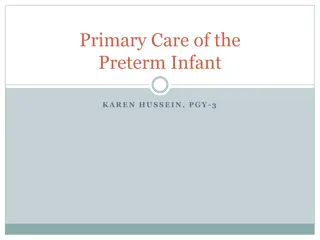Understanding the Organization of NICU: A Comprehensive Guide
The organization of a Neonatal Intensive Care Unit (NICU) plays a vital role in reducing neonatal mortality and improving the quality of life for newborns. This comprehensive guide covers the objectives, definition, basic facilities, levels of care, and components of a NICU. It emphasizes the importance of SCNU in managing complex diseases and providing life-saving therapies for critically ill newborns.
Download Presentation

Please find below an Image/Link to download the presentation.
The content on the website is provided AS IS for your information and personal use only. It may not be sold, licensed, or shared on other websites without obtaining consent from the author. Download presentation by click this link. If you encounter any issues during the download, it is possible that the publisher has removed the file from their server.
E N D
Presentation Transcript
seminar on:- organization of nicu
Objective Introduce the organization of nicu Define the nicu. Discuss the objective of nicu List out the basic facility of nicu Describe the levels of nicu. Explain the component of nicu.
INTRODUCTION- The organization of a good quality special care neonatal unit (SCNU) is essential for reducing the neonatal mortality and improving the quality of life among the survivors. Govt. of India has launched an initiative to establish SCNUs at district hospitals to provide. Care at birth including resuscitation of asphyxiated newborns. Management of sick newborns. Referral and transport services for babies needing mechanical ventilation and major surgical interventions. Post-natal care and immunization services Follow-up of high risk newborns
DEFINIION- NEONATAL CARE:- The management of complex life threatening diseases, provision of intensive monitoring and institution of life sustaining therapies in an organized manner to critically ill children in a separate pediatric intensive care unit.
OBJECTIVE- To save the life of the sick new born To prevent damage in infants with problems at birth and also reduce morbidity in later life To monitor high risk newborns so as to reduce mortality and morbidity in these babies.
BASIC FACILITIES: Adequate space Availability of running water Centralized oxygen and suction facilities Maintenance of thermo- neutral environment Facilities for availability to treat common neonatal problems
LEVELS- India has 3-tier system of neonatal care based on weight and gestational age of neonate. Level I care- For care of newborns more than 1800 grams or G.A. 34 weeks. The care consists of basic care at birth, provision of warmth, maintaining asepsis and promotion of breastfeeding. This type of care can be given at home, subcenter and primary health centre.
Level II care Neonates weighing 1200-1800 grams or G.A. between 30 34 weeks are categorized under level II care and are looked after by trained nurses and pediatricians. The equipment and facilities used for this level of care include equipment for resuscitation, maintenance of thermoneutral environment, intravenous infusion, gavage feeding, phototherapy and exchange blood transfusion. This type of care can be given at first referral units, district hospitals, teaching institutions and nursing homes.
Level III care- Neonates weighing less than 1200 grams or having gestational maturity of less than 30 weeks are categorized under level III care. The care is provided at apex institutions and regional perinatal centres equipped with centralized oxygen and suction facilities, servo-controlled incubators, vital signs monitors, transcutaneous monitors, ventilators, infusion pumps etc.
COMPONENTS- Main Components To Be Consider While Organizing A Nicu: Physical Facilities. Personnel. Equipment s. Laboratory Facilities. Procedure Manual. Transport Of Sick Infants. Cooperation Between The Obstetrician And Neonatologist.
Space- The size of the unit is related to the expected population intended to be served. In a maternity unit having 2000 deliveries/year, facilities for special care of 6- 8 high risk infants should be available. Each infant should be provided with a minimum area of a 100 sq ft (10 meter square). There should be no compromise on space and its adequacy is crucial for reduction of nosocomial infections
Location- The neonatal unit should be located as close as possible to the labour room and obstetric operation theatre to fecilitate prompt transfer of sick neonate. The presence of an elevator in close proximity is desirable for transport of out born babies.
Nursery design- The unit design may be in a square space or a single corridor based rectangular unit. A split unit (on either side of the hospital corridor) should be avoided, for prevention of infections.
Baby Care area- The unit should be provided with areas and rooms for inborn or intramural babies, step down nursery, out born or extramural babies, examination area, mother s area for breastfeeding and expression of breast milk, nurses station and charting area. The obviously infected infants with open sepsis (especially those with diarrhea and abscesses) should be isolated in a septic nursery, which should be located away from the SCNU and manned by different nursing and resident staff.
Examination area- A small comfortable room with examination table, comfortable seating, sufficient light, and warmth is needed for assessment of baby before admission to the nursery. Mother area- The room should be provided with comfortable seating and privacy to the mother to breastfeed and express the breast milk with the help of a lactation nurse.
Handwashing and gowning - A positive air pressure should be maintained in the SCNU so that corridor air does not enter the SCNU . Street shoes are changed with nursery slippers, followed by handwashing and gowning. Hand free elbow-operated handwashing sink with liquid soap dispenser is recommended. Handwashing sinks should be provided within 20 feet (6 meters) of every newborn bed . The sink should be large and deep (24 wide 16 front-back 10 deep). Antiseptic sanitizing solution (sterillium) can be used for disinfection of hands in-between the babies.
Preparation of intravenous fluids- A separate area should be provided with a laminar flow system for preparation of intravenous fluids, parenteral nutritional formulations, enteral feeds and medications.
Nurses station- Nursing station and charting area for nurses and residents should be located in a central area from where all the babies can be observed. New-born charts, hospital forms, computer terminals, telephone lines should be located in this area. It is preferable to use electronic medical recording of clinical notes and retrieval of laboratory reports.
Clean utility and soiled utility holding rooms- There should be enough space for stocking clean utility items and sterile disposables, and for disposal of dirty linen and contaminated disposables. The ventilation system in the soiled utility or holding room should be engineered to have negative air pressure with all air being exhausted to the outside. The soiled utility room should be so located that it enables removal of soiled material without passing through the baby care area.
Staff rooms- Space should be provided within the unit to meet the professional, personal and administrative needs of resident staff on duty. A comfortable room with intercom, telephone and computer terminal and WC facilities is mandatory. Nurse s Change room is required for changing from formal street clothes to dress stipulated by the NICU.
Growing nursery- A separate area for transitional care of high-risk babies by their mothers before they are discharged from the hospital . The entry of visitors to this area should be restricted and it should be kept adequately warm. Facilities for vitals monitoring and weighing the babies should be available in the transitional care room (TCR) or growing nursery (GN). The growing nursery is used with advantage for educating the mothers in child craft activities and promoting the practice of exclusive breastfeeding.
Ventilation- Effective air ventilation of nursery is essential to reduce nosocomial infections . The most satisfactory ventilation is achieved with laminar air flow system which is rather expensive. When centralized air-conditioning is used, minimum of 12 changes of room air per hour are recommended. There should be no draughts of air on and near the new born beds. The air-conditioning ducts must be provided with Millipore filters (0.5 u) to restrict the passage of microbes.
Conti.. A simple method to achieve satisfactory ventilation consists of provision of exhaust fan in a reverse direction near the ceiling for input of fresh uncontaminated air and fixation of another exhaust fan in the conventional manner near the floor for air exit. The use of chemical air disinfection and ultraviolet lamps is no more recommended.
Lighting- The nursery must be well illuminated and painted white or slightly off white to permit prompt and early detection of jaundice and cyanosis. It is best achieved by cool white fluorescent tubes or LED (light-emitting diodes) to provide at least 100 foot-candle, shadow free illumination at the infant s level. Spot illumination for various procedures can be provided by a portable angle- poise lamp having two 15 watt fluorescent bulbs which when held at a distance of about one foot from the infant, produce about 100 foot candle intensity of light. In places where electrical failure is frequent and prolonged, the electrical system of the nursery complex must be attached to a generator. .
Conti Spot illumination for various procedures can be provided by a portable angle- poise lamp having two 15 watt fluorescent bulbs which when held at a distance of about one foot from the infant, produce about 100 foot candle intensity of light . In places where electrical failure is frequent and prolonged, the electrical system of the nursery complex must be attached to a generator. .
STAFF- A direct who is a full time neonatologist . One neonatal physician is required for every 6-10 patients One resident doctor should be present in the unit round-the-clock. Anaesthetist - paediatric surgeon and paediatric pathologist are essential persons in establishment of a good quality NICU A nurse : patient ratio of 1:1 maintained thought out day and night is absolutely essential for babies on multi system support including ventilatory therapy. For special care neonatal unit and intermediate care, nurse to patient ratio of 1:3 is ideal but 1:5 per shift is manageable.
Conti. Head nurse is the overall in-charge In addition to basic nursing training for level-II care, tertiary care requires, staff nurse need to be trained in handling equipment, use of ventilators and initiation of life-support like use of bag and mask resuscitation, endotracheal intubations, arterial sampling and so-on. The staff must have a minimum of 3 years work experience in special care neonatal unit in addition to having 3 months hand- on- training in an intensive care neonatal unit.
EQUIPMENT- During the last 2- 3 decades, a large number of monitoring devices for diagnostic and therapeutic use for the high-risk newborn infants have been developed . Several basic prerequisites must be fulfilled before any centre invests in purchase of expensive equipment involving foreign exchange. The fundamental needs of the unit are availability of adequate space, freedom from congestion and presence of a sufficient number of adequately trained nurses. Acquisition of new equipment does not necessarily ensure better services and outcome. Machines cannot replace men. The best monitors with us are dedicated nurses and resident doctors involved in the care of newborn babies with their observational skills sharpened by experience. Therefore, they need continued in service training.
Conti.. Acquisition of new equipment does not necessarily ensure better services and outcome. Machines cannot replace men. The best monitors with us are dedicated nurses and resident doctors involved in the care of new born babies with their observational skills sharpened by experience. Therefore, they need continued in service training.
Preventive maintenance and emergency repairs The objectives of preventive maintenance include that the equipment should be functional most of the time and should operate with accuracy, efficiency and safety. The maintenance engineer should undertake at least two technical visits per year to check the wear and tear, and performance of the device as per manufacturers technical check list. He should interact with in-house technician and end-users to provide necessary guidance for correct use of the equipment to ensure effective preventive maintenance
Conti. Emergency tray should be available in each infant care room of SCNU containing Ambu bag and mask, infant laryngoscope, tracheal tubes of different sizes, sterile suction catheters, oral mucus suction traps, and emergency drugs. Bag and Mask Resuscitator -Self-inflating bag of 250 / 500 mL capacity is ideal for resuscitation of a newborn baby. An oxygen reservoir in the form of a corrugated tube or reservoir bag, helps to increase the oxygen concentration to 90 to 100%.
Oxygen and suction facility- Catheter syringes and needles Feeding equipment's- glass and stainless steel bowels of adequate size Weighing machine Pulse Oximeter Infusion or syringe pump Blood Pressure Monitors
Laminar flow system- The laminar flow system is useful for safe and aseptic formulation and mixing of drugs, parenteral fluids and nutrients. It is equipped with high efficiency particulate aggregate (HEPA) filter to filter out bacteria, a blower and plenum. Two types of systems are available. In a vertical type system, the air flows from above downwards and it is recommended for use in the NICU. Ultraviolet light source in the chamber is kept on for 30 minutes before use to make the area of operation free of bacteria. Strict asepsis should be ensured by wearing mask, sterile gown and disposable gloves while operating the laminar flow system.
Incubators- The incubators are essential to provide an ideal microenvironment for high-risk babies. About one third of nursery beds should comprise of incubators. It is desirable to nurse extremely low birth weight (<1000 g) stable babies in the incubator. The sensory stimuli, like light, sound, touch and pain, should be kept to the minimum without compromising the quality of care.. Even when sterile water is used in the humidity tank, incubators are a potential source of infection. The water in the humidity tank should be changed daily and 1 -2 mL of glacial acetic acid or vinegar should be added to prevent bacterial colonization
Radiant Warmer/Open Care System- - During various procedures, the infant loses body temperature, unless he is kept warm by use of radiant heat warmer. When an overhead radiant warmer is intended to be used for a prolonged period, it should be combined with a skin sensor and a servo control system Skin probe is applied over the liver area in the epigastrium and shielded with a foil covered foam adhesive pad. These units also have a provision for overhead light source and phototherapy unit and are most suitable for undertaking any prolonged procedure, like assisted ventilation, exchange blood transfusion or surgery.
Oxygen Concentrator- Oxygen is supplied through central Oxygen source or portable oxygen cylinders. Portable oxygen cylinders are expensive and not readily available in a district hospital or community health centre. The atmospheric air is passed through a chemical zeolite (aluminium silicate) which absorbs all gases except oxygen. It can increase the concentration of oxygen in the air from 21% to about 90%. The oxygen sensor device (OSD) shows a green signal when oxygen concentration in the outlet exceed 90%
Conti The equipment is provided with four filters to eliminate dust, humidity and bacteria. Depending upon the flow rate, various concentrations of oxygen can be delivered to the patient. Oxygen must be warmed (36.0 - 36.5 C) and humidified before administration to the baby. Oxygen concentrators are cost-effective and promoted by WHO in developing countries.
Oxygen Analyzer This is useful for Monitoring ambient oxygen concentration in order to protect the infant against oxygen toxicity. It helps in regulating the flow rate of oxygen so that desired concentration of oxygen is delivered to the infant depending upon his clinical condition and oxygen requirements. The newer oxygen analyzers provide continuous digital display of oxygen concentration and trigger off audio visual warning signal when environmental concentration of oxygen falls or rises beyond the safety levels . The instrument is calibrated by checking the oxygen concentration of room air which is kept constant at 21%.
Phototherapy Unit- Phototherapy is now generally accepted as a safe and effective method for treatment of neonatal hyperbilirubinemia. A light source designed to give an irradiance or flux of 10-30 uW/cm2/nm between 400 -520 nm wavelength range at the mattress is ideal. The infant may be exposed under a portable or fixed blue light source (425 to 475 nm) kept at a distance of about 18 inches (45 cm) from the skin. Double-light system, where total baby is exposed from below and above, has been used for more effective light exposure, but it is uncomfortable and unfriendly to the baby who is made to lie on a cold and hard Perspex sheet.
Conti Instead, intensive single surface phototherapy can be given by using tubes providing greater irradiance by reducing the distance between the tubes and the baby to 15 -20 cm. The effect of phototherapy unit can be enhanced by using slings or curtains made of white cloth or aluminium to reflect light on the baby.
COT-SIDE LABORATORY FACILITIES- Satisfactory facilities for routine radiological examination should be available in the nursery round-the clock. A side laboratory for routine analysis of blood, urine, glucose, bilirubin, hematocrit should be available Facilities for analysis of serum sodium, potassium, calcium and total serum proteins, and albumin should be at hand.
Conti. The collection of venous blood is often difficult and hazardous in sick preterm babies. These babies often require frequent biochemical estimation. Thus a microchemical laboratory which can carry out investigations on very small samples of blood obtained in heparinized capillary tubes or microcentrifuge tubes from heel puncture, should be considered as an essay for SCNU.
summary Aneonatal intensive care unit (NICU) is a hospital unit that specializes in caring for babies who are born prematurely, require extra monitoring, or are sick/injured. Babies may need to spend time in the NICU if they are showing indications of potential brain, heart, or lung problems





